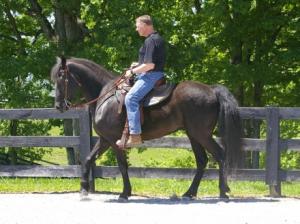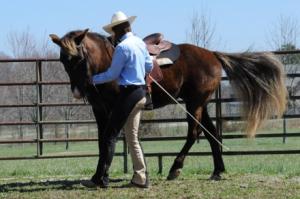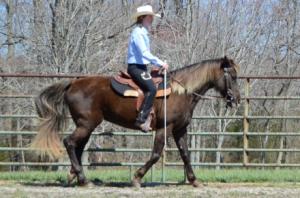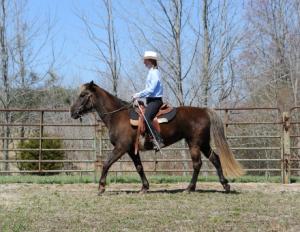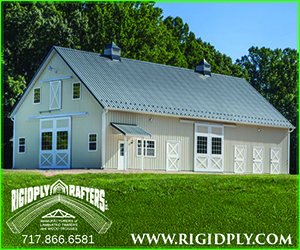By Larry Whitesell
Does your horse pace? Many people offer solutions to pacing, but they often don't cure the cause of the problem. We don't want to fix the symptons; we want to cure the “disease.” We need to understand biomechanically and emotionally why the horse paces.
A horse that paces is tense in the neck and back. It, therefore, loses freedom of movement in its joints, throwing off the timing of footfall or rhythm. As a result of tense movements, the horse becomes heavy on the forehand. A pacy horse is constantly in a poor state of balance, which contributes to its tenseness. Rhythm and cadence are key to relaxation, and softness doesn't exist without rhythm. When we try to correct the horse from pacing, instead of solving the horse’s problems that cause pace, we often make the problem worse. Anything that disrupts rhythm or cadence will slow down the hind foot in relation to the front foot.
Often we are told to ride a pacy horse over poles or up hills to break up pace. While we are going over the poles or up the hill, the horse breaks up the pace, but usually paces again as soon as it is on level ground. Also, riding a pacy horse in high grass or deep footing breaks up pace. But what happens biomechanically in this temporary fix that we could teach the horse to make it permanent? These things change the way the horse uses his hind end joints, which changes balance and the timing of the footfall.
When the horse crosses poles, goes in deep footing or uphill, the horse has to flex the hind end joints more. When he has to pick the hind feet up more, instead of swinging the leg, the action flexes in the hind joints. He, therefore, keeps his hind legs more under him instead of swinging them too far forward or out behind him. He will also move with more power instead of thrusting himself forward. Now the hind foot will set down a second sooner, creating gait instead of pace.
A horse with an exaggerated overstride will take longer for the hind foot to land, often causing it to land the same time as the front foot. Overstride at walk is normal for all horses, gaited or trotting, but horses that exaggerate overstride swing the hind leg like a pendulum, with no flexion in the joints. The hind leg, then, not only overstrides, but also swings way out behind the point of the tail, making the horse out of balance. In any animal, even people, tenseness in joints slows down the limb it is moving. When horses do an exaggerated overstride and the joints are stiff, then the horse pronates the hind foot, and it will lose rhythm. [Pronationis the inward roll of the foot while walking or running.]We see many gaited horses that twist their hocks when turning.
In classical training, we are taught that roundness frees the hips and hips create roundness. For the hips to create roundness, the hind joints must flex. While you get some roundness by lowering the head, without the hind end tilting to lift the withers, the horse will just be on the forehand. Head position is determined by the horse’s conformation and strength. Raising the head too early will contribute to pace because the spine inverts due to the young or unschooled horse not having developed the correct muscles. Lowering the head without lifting the horse at the withers may result in pace as soon as you ask for more speed. The horse will be on his shoulders and the hind legs can't work with flexion, or freedom of movement. When transitioning from walk to gait, if the ears go up instead of forward, pace is likely.
The more a horse moves the more it relaxes and the more it relaxes the freer it moves. If you hold a horse in posture then movement will become tense. In our attempt to get a horse to gait, we tap or kick to get movement instead of relaxation, and we often hold the horse back while kicking him forward; in other words, we have the brakes and accelerator on at the same time. Many times horses are driven into a fixed hand to gait so that relaxation is sacrificed in the attempt to make the horse gait. If you need stronger equipment as you ask for speed or gait, then softness is not present.
Teaching a horse to use his joints freely and in the healthiest way will help him have good rhythm. This also makes the horse softer and lighter. We need to do things that keep the muscles that move the joints tension free. Learning to ride in balance and in ways that don't interfere with the horse’s movements is a good start. Riding in balance frees up our ability to not have tension in our joints. If there is tension in our body to keep our balance, this tenses the horse’s back, because the tension in our body does not allow the horse’s body to move. This tension in us will lead to pace in the horse because the horse cannot free his spine. We continue to take riding lessons from classical riding instructors. It is a never ending process. When you ride, do you use your aids to make the horse do a movement, or prepare his posture and explain to him how he will do the movement in balance?
Trail riding, or just going up and down hills, can supple a horse, if the rider is in balance and uses the aids correctly. Sitting on your pockets instead of in a balanced position puts stress on the horse’s lumbar region, slowing the hind legs coming forward. Especially when going up or down hills, we need to get off the horse’s spine so he can use his hind legs more effectively. Backing a horse can either teach the horse to flex the hind joints or invert the back and move backward from the front legs. If the horse rounds the back, lowers the head, shift weight back, then he flexes longitudinally and develops correct muscles.
Riders who pull on the horse with the reins will cause the horse to lock his jaw. If the horse locks the jaw, then the horse will tense the neck, back, and pelvis. Unlocking the jaw is another chapter in itself. In order to get tension out of the back and neck, we need to do lateral exercises that flex the horse through the length of his spine – ears to tail. As riders we are taught that circles, turns and serpentines supple the horse. Doing these exercises is very good, but if the horse is out of balance while doing them, then the back remains tense, leading to pace. Teaching horses to turn or do circles correctly will help the horse stop pacing. If the rider pulls or holds the inside rein, leans, or the horse is on the inside shoulder, then muscles will tense to catch the horse from falling. This is another major contributor to pace.
When teaching a young horse to turn or circle, the horse must learn to turn by putting the inside hind leg under his center of gravity or center line, so it can support in the turn, rather than the inside front leg. Horses with exaggerated overstride will always turn out of balance because they cannot flex the hind leg and rotate the pelvis to put the inside hind leg under the center line. Because the exaggerated overstride means the horse doesn’t flex the hock and stifle, it pronates or swings the hind leg forward, not underneath the body. Horses that don’t flex the stifle will also be tense in the poll, all affecting the timing of the hind foot. Fixing this will also fix pace because the horse in balance can bring the hind leg forward and set it down so that it lands just before the front foot.
Horses with exaggerated over stride cannot bend the ribs to get a bend the length of their body if they cannot put the inside hind leg underneath. A horse that uses his legs correctly and bends in the ribs will lift the rider’s inside seat bone when he brings his leg under. If he is having trouble, you can put a little weight in the outside stirrup in the turns to encourage him to bring his hind leg under and turn in a better balance. This will also help him bend in the ribs. Make sure you, as a rider, are turning your core and shoulders and not just using the hands to turn the horse or hold him on the circle.
Another very common problem that contributes to pace is riders who allow their horse to walk like a slug down the trail. Over time the joints become stiff from lack of use or movement. Doing transitions to teach your horse to have an energetic walk will help with gait. It is much easier for a horse to gait from an energetic walk because he will start to shift weight more evenly to all four feet. Horses that have a very dull walk get on the forehand and, over time, develop incorrect muscles. Horses who walk energetically have enough impulsion in the hind quarters to make easy transitions to the next gait, whatever it may be. Horses who habitually have a dull walk are always in a poor balance to move up to the next gait. To get gait from a horse genetically bred to gait, he must have an energetic hind end.
It has been our experience that if you train a horse correctly, teaching the things that are important to the horse (balance, understanding the aids, softness) the horse will offer gait when he is ready. When things are done to make the horse gait, problems always result. Often the horse has to be held in gait by the rider and the horse breaks if he turns or changes speed. The horse should be able to gait at all speeds and in turns or change direction without breaking gait. When riders try to make the horse do the gait that they believe he should do, or the one in the breed brochure, then tension is usually a resulting problem. Horses that have not been developed correctly don’t have the physical strength to do the finished gaiting product. Trying to make him do the “signature gait” in the beginning can create stress mentally, which leads to physical tension. Just teach him what he needs systematically and he will offer the best gait he is capable of at his current stage of development. As he develops muscle and balance and understanding, the gait will get better and better.
For more information, see: Jennifer Bauer www.gaitedhorsemanship.com or Larry Whitesell at: www.whitesellgaitedhorsemanship.com
Does your horse pace? Many people offer solutions to pacing, but they often don't cure the cause of the problem. We don't want to fix the symptons; we want to cure the “disease.” We need to understand biomechanically and emotionally why the horse paces.
A horse that paces is tense in the neck and back. It, therefore, loses freedom of movement in its joints, throwing off the timing of footfall or rhythm. As a result of tense movements, the horse becomes heavy on the forehand. A pacy horse is constantly in a poor state of balance, which contributes to its tenseness. Rhythm and cadence are key to relaxation, and softness doesn't exist without rhythm. When we try to correct the horse from pacing, instead of solving the horse’s problems that cause pace, we often make the problem worse. Anything that disrupts rhythm or cadence will slow down the hind foot in relation to the front foot.
Often we are told to ride a pacy horse over poles or up hills to break up pace. While we are going over the poles or up the hill, the horse breaks up the pace, but usually paces again as soon as it is on level ground. Also, riding a pacy horse in high grass or deep footing breaks up pace. But what happens biomechanically in this temporary fix that we could teach the horse to make it permanent? These things change the way the horse uses his hind end joints, which changes balance and the timing of the footfall.
When the horse crosses poles, goes in deep footing or uphill, the horse has to flex the hind end joints more. When he has to pick the hind feet up more, instead of swinging the leg, the action flexes in the hind joints. He, therefore, keeps his hind legs more under him instead of swinging them too far forward or out behind him. He will also move with more power instead of thrusting himself forward. Now the hind foot will set down a second sooner, creating gait instead of pace.
A horse with an exaggerated overstride will take longer for the hind foot to land, often causing it to land the same time as the front foot. Overstride at walk is normal for all horses, gaited or trotting, but horses that exaggerate overstride swing the hind leg like a pendulum, with no flexion in the joints. The hind leg, then, not only overstrides, but also swings way out behind the point of the tail, making the horse out of balance. In any animal, even people, tenseness in joints slows down the limb it is moving. When horses do an exaggerated overstride and the joints are stiff, then the horse pronates the hind foot, and it will lose rhythm. [Pronationis the inward roll of the foot while walking or running.]We see many gaited horses that twist their hocks when turning.
In classical training, we are taught that roundness frees the hips and hips create roundness. For the hips to create roundness, the hind joints must flex. While you get some roundness by lowering the head, without the hind end tilting to lift the withers, the horse will just be on the forehand. Head position is determined by the horse’s conformation and strength. Raising the head too early will contribute to pace because the spine inverts due to the young or unschooled horse not having developed the correct muscles. Lowering the head without lifting the horse at the withers may result in pace as soon as you ask for more speed. The horse will be on his shoulders and the hind legs can't work with flexion, or freedom of movement. When transitioning from walk to gait, if the ears go up instead of forward, pace is likely.
The more a horse moves the more it relaxes and the more it relaxes the freer it moves. If you hold a horse in posture then movement will become tense. In our attempt to get a horse to gait, we tap or kick to get movement instead of relaxation, and we often hold the horse back while kicking him forward; in other words, we have the brakes and accelerator on at the same time. Many times horses are driven into a fixed hand to gait so that relaxation is sacrificed in the attempt to make the horse gait. If you need stronger equipment as you ask for speed or gait, then softness is not present.
Teaching a horse to use his joints freely and in the healthiest way will help him have good rhythm. This also makes the horse softer and lighter. We need to do things that keep the muscles that move the joints tension free. Learning to ride in balance and in ways that don't interfere with the horse’s movements is a good start. Riding in balance frees up our ability to not have tension in our joints. If there is tension in our body to keep our balance, this tenses the horse’s back, because the tension in our body does not allow the horse’s body to move. This tension in us will lead to pace in the horse because the horse cannot free his spine. We continue to take riding lessons from classical riding instructors. It is a never ending process. When you ride, do you use your aids to make the horse do a movement, or prepare his posture and explain to him how he will do the movement in balance?
Trail riding, or just going up and down hills, can supple a horse, if the rider is in balance and uses the aids correctly. Sitting on your pockets instead of in a balanced position puts stress on the horse’s lumbar region, slowing the hind legs coming forward. Especially when going up or down hills, we need to get off the horse’s spine so he can use his hind legs more effectively. Backing a horse can either teach the horse to flex the hind joints or invert the back and move backward from the front legs. If the horse rounds the back, lowers the head, shift weight back, then he flexes longitudinally and develops correct muscles.
Riders who pull on the horse with the reins will cause the horse to lock his jaw. If the horse locks the jaw, then the horse will tense the neck, back, and pelvis. Unlocking the jaw is another chapter in itself. In order to get tension out of the back and neck, we need to do lateral exercises that flex the horse through the length of his spine – ears to tail. As riders we are taught that circles, turns and serpentines supple the horse. Doing these exercises is very good, but if the horse is out of balance while doing them, then the back remains tense, leading to pace. Teaching horses to turn or do circles correctly will help the horse stop pacing. If the rider pulls or holds the inside rein, leans, or the horse is on the inside shoulder, then muscles will tense to catch the horse from falling. This is another major contributor to pace.
When teaching a young horse to turn or circle, the horse must learn to turn by putting the inside hind leg under his center of gravity or center line, so it can support in the turn, rather than the inside front leg. Horses with exaggerated overstride will always turn out of balance because they cannot flex the hind leg and rotate the pelvis to put the inside hind leg under the center line. Because the exaggerated overstride means the horse doesn’t flex the hock and stifle, it pronates or swings the hind leg forward, not underneath the body. Horses that don’t flex the stifle will also be tense in the poll, all affecting the timing of the hind foot. Fixing this will also fix pace because the horse in balance can bring the hind leg forward and set it down so that it lands just before the front foot.
Horses with exaggerated over stride cannot bend the ribs to get a bend the length of their body if they cannot put the inside hind leg underneath. A horse that uses his legs correctly and bends in the ribs will lift the rider’s inside seat bone when he brings his leg under. If he is having trouble, you can put a little weight in the outside stirrup in the turns to encourage him to bring his hind leg under and turn in a better balance. This will also help him bend in the ribs. Make sure you, as a rider, are turning your core and shoulders and not just using the hands to turn the horse or hold him on the circle.
Another very common problem that contributes to pace is riders who allow their horse to walk like a slug down the trail. Over time the joints become stiff from lack of use or movement. Doing transitions to teach your horse to have an energetic walk will help with gait. It is much easier for a horse to gait from an energetic walk because he will start to shift weight more evenly to all four feet. Horses that have a very dull walk get on the forehand and, over time, develop incorrect muscles. Horses who walk energetically have enough impulsion in the hind quarters to make easy transitions to the next gait, whatever it may be. Horses who habitually have a dull walk are always in a poor balance to move up to the next gait. To get gait from a horse genetically bred to gait, he must have an energetic hind end.
It has been our experience that if you train a horse correctly, teaching the things that are important to the horse (balance, understanding the aids, softness) the horse will offer gait when he is ready. When things are done to make the horse gait, problems always result. Often the horse has to be held in gait by the rider and the horse breaks if he turns or changes speed. The horse should be able to gait at all speeds and in turns or change direction without breaking gait. When riders try to make the horse do the gait that they believe he should do, or the one in the breed brochure, then tension is usually a resulting problem. Horses that have not been developed correctly don’t have the physical strength to do the finished gaiting product. Trying to make him do the “signature gait” in the beginning can create stress mentally, which leads to physical tension. Just teach him what he needs systematically and he will offer the best gait he is capable of at his current stage of development. As he develops muscle and balance and understanding, the gait will get better and better.
For more information, see: Jennifer Bauer www.gaitedhorsemanship.com or Larry Whitesell at: www.whitesellgaitedhorsemanship.com
